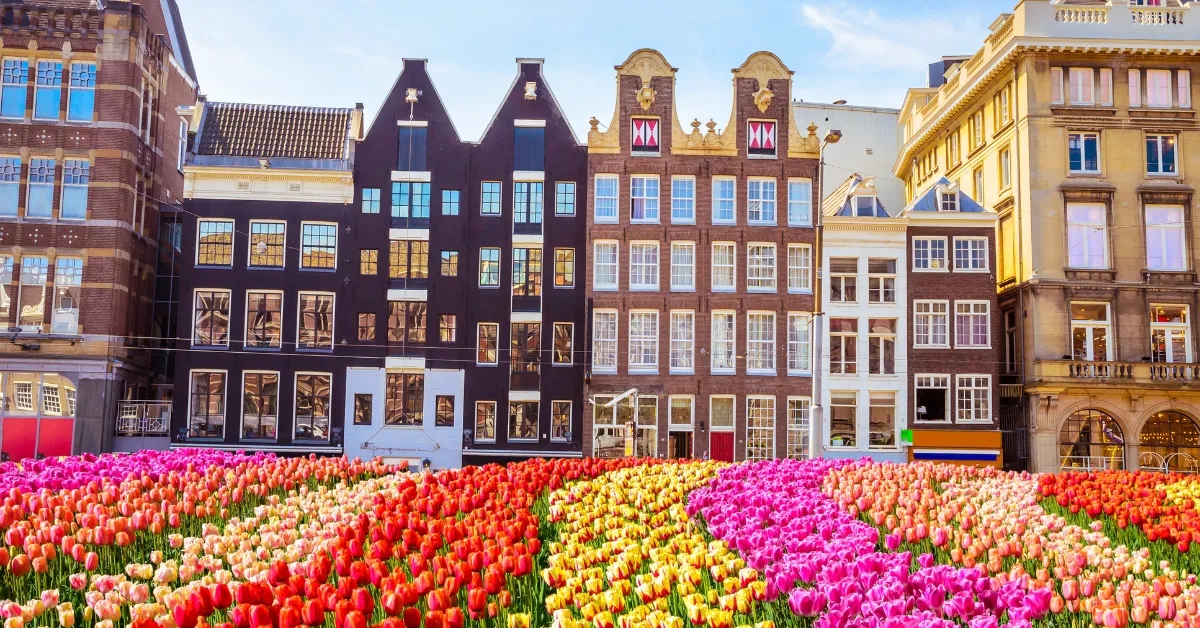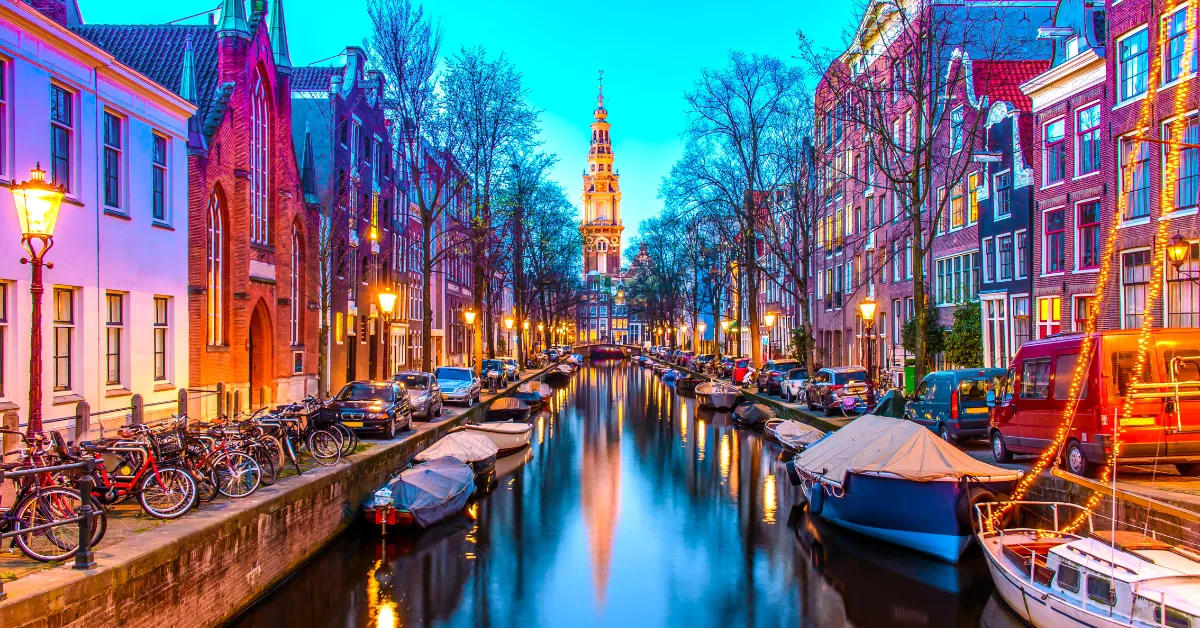If you’re the type of person who loves to look at the advantages and disadvantages of moving to a city before booking a flight, you’re in the right place.
In this post, we’ll be diving into the pros and cons of living in Amsterdam — the Dutch capital that draws in ex-pats from around the globe.

While the city is known for its windmills, bicycles, and questionable brownie flavors, there is plenty more to the city than meets the eye. From its annual flower festivals to its small-town feel, you’re sure to fall in love with Amsterdam at first sight.
But, does that make the city a good place to live? There’s a big difference between a two-week vacation and a permanent move, which is why we’re weighing up the advantages and disadvantages of living in Amsterdam. Just keep reading to find out these key points.
Pros Of Living In Amsterdam
There are many pros of living in Amsterdam. In fact, we could be here all day writing positive things about the Dutch city, but you’d get bored of reading this post. Here are the best benefits of moving to Amsterdam in a nutshell.
Cycle-Friendly City
Forget needing a car to get around. What you need in Amsterdam is a bicycle. On average, 60% of the city’s population uses bicycles every day, because of its dedicated cycling network. Ample infrastructure is in place, making it easy to get around the city by bike.
Cycling is also a great way to offset high living costs, as once you’ve paid for the bicycle itself, there are no maintenance or running costs. You can find many bike shops around Amsterdam, selling new and second-hand cycles.
This can be a good option as even pre-loved bikes often come with a warranty that lasts a couple of months. However, bike shops do charge a high markup and you can expect to pay upwards of €120 for a used bicycle.
You can also take a walk to Waterlooplein Market, which is in the city’s center and always has a display of second-hand bikes.
Alternatively, there are plenty of people looking to flog their old bike for a decent price online. You can check out Facebook groups, such as Bike Marketplace — Amsterdam, or ask around when you arrive to find a good quality second-hand bike.
Easy To Travel From
Situated in the heart of Europe, it’s easy to travel across the continent from Amsterdam. Europe is known for its easy cross-country train travel, which, in many cases, takes just a few short hours. You can access several other countries directly from Amsterdam, including Austria, Belgium, France, Germany, and the UK.
There are also many budget airlines that enable you to travel between Amsterdam and other neighboring countries for less than the price of a meal.
If you do have a car, you can plan scenic road trips from the city, either across the Netherlands or further afield.
Arts And Culture
Another benefit of living in Amsterdam is its vibrant culture and rich history. From its canals to its museums, there is plenty to be seen around the city. There are countless exhibitions, galleries, and theaters to explore in Amsterdam, such as the Rijksmuseum, which includes masterpieces by Van Gogh and Rembrandt.
There is also the infamous Anne Frank House, where the young girl hid from the Nazi occupation during World War II. You can see the small living quarters Anne shared with her family and learn all about her short life.
The city hosts several festivals throughout the year, including the Tulip Festival, which takes place in the spring and has been running since 1929. Amsterdam celebrates Gay Pride annually with a week-long fiesta, which includes street parties and a parade along the canal.
Large Expat Community
One of the largest pros of living in Amsterdam for those who wish to make like-minded friends is that there is a large ex-pat community waiting to welcome you. Amsterdam is extremely diverse and you’ll find people from all walks of life living there.
In fact, somewhere between 80,000 and 110,000 foreigners claim the city as their home, which means you’re never far from someone with a similar story to you. With around 800,000 residents in Amsterdam, over 10% are foreigners.
The three most popular neighborhoods for ex-pats are Amsterdam Noord, Amsterdam Zuid, and De Pijp. There are also over 100 coworking spaces, which means you’ll find integrating yourself into this mixing pot of cultures relatively easy.
Good Quality Of Life
Amsterdam has been known for its high quality of living for several years. In 2021, the city nabbed the top spot in a study that ranked 44 cities to see which was the best for living a happy and healthy life. It was ranked on several factors, including obesity levels, air and water quality, and happiness levels.
Residents of Amsterdam work fewer hours than in many cities worldwide, and workers know how to maintain the work-life balance that is so elusive in other western countries.
There are plenty of outdoor activities to participate in around the city, even if you may sometimes get caught in the rain.
Good healthcare and education systems are also in place, which are important factors to consider when moving to a destination long-term.
Cons Of Living In Amsterdam
Despite the many positive factors of the city, there are a few cons to living in Amsterdam. While for some people, these won’t be deal breakers, others may want to check out alternative destinations.
Cost Of Living
The cost of living is one of the biggest driving factors when it comes to deciding where to live. While Amsterdam has got many things going for it, on the flip side, it is a relatively expensive place to live.
Compared to the rest of Europe, the city is on the higher end of the pricing spectrum and certainly compared to cities in other continents, such as Asia, the cost of living is worlds apart.
In saying that, Amsterdam is hardly the most expensive city in the world and has been ranked joint 40th in the Worldwide Cost of Living Index, well behind other large cities, such as Tel Aviv, Paris, Singapore, and Zurich.
You’ll need approximately €3,000 per month to live comfortably in Amsterdam as a single person. Let’s break that down into different categories.
Accommodation will be your biggest expense. If you choose to live in a studio apartment, you’ll pay around €1,300 and can expect the property to be furnished.
If you wish to have a little more room to spare, you’ll pay €1,900 for a much larger apartment. Those who want to live in a desirable neighborhood will pay a premium for it. You can add anything from €200 to €500 to your rent to live in the most up-and-coming area of the city.
Household utilities, such as electricity and gas will set you back around €200 per month, depending on the size of your apartment. If you wish to have a gym membership, you’ll pay, on average, €50.
You can expect to pay approximately €100 for a monthly public transportation pass. However, you may find it possible to cycle everywhere in the city for free.
Difficulty Attaining Housing
No matter where you are in the world, you need a roof over your head. Another drawback of living in Amsterdam is that the demand for housing outweighs the supply. Not only does this drive the prices of accommodation up, but it can make life stressful when you arrive in the city.
You need to be on housing websites daily and call the rental company immediately once you come across a property that suits you to be in with a chance of securing a home.
Once you have found somewhere to live, you may be underwhelmed by the amount of space you have. Like in many capital cities, Amsterdam’s housing is often cramped, meaning you may have to be a minimalist to enjoy your living space.
Lots Of Paperwork
If you’re an EU citizen, you’ll find moving to Amsterdam relatively easy. That’s because all countries in the European Union allow free movement. You can move to any country in the EU in order to work, study, look for a job, or retire.
You don’t even need to register that you’re living in a country for the first three months.
However, if you’re a resident from a country outside of the EU, you’ll find it much harder to obtain a visa. It’s still possible to live in Amsterdam if you’re from outside the EU and you shouldn’t let the lengthy process of getting a visa put you off from moving to the city.
However, it is one of the biggest cons of living in Amsterdam and definitely worth being aware of before you plan your big move.
Regardless of whether you’re an EU citizen or not, once you arrive in the city, you’ll need to open a Dutch bank account and register with the municipality — otherwise known as the city council.
Final Thoughts On Pros And Cons Of Living In Amsterdam
What are your thoughts after reading this list of pros and cons of living in Amsterdam? You might have found that there are endless advantages and have already started house hunting.
On the flip side, the disadvantages might have you wondering whether it’s really the right move for you.
If you’re looking for a thriving cultural scene and a place where you can meet other expats, Amsterdam is likely to be the perfect city for you. However, if money is your main deciding factor, you may wish to look elsewhere.
If you want to explore other destinations, check out these posts:
- Pros and cons of living in Poland
- Pros and cons of living in Malaysia
- Best coworking spaces in Prague
Do you have your travel insurance?
- ☑ SafetyWing offers affordable travel medical insurance. Prices start at $45.08 / 4 weeks.
- ☑ Created by nomads, for nomads.
- ☑ Covers quarantine and Covid-19.
- ☑ You can pay per month, and stop at anytime.


